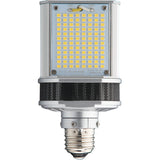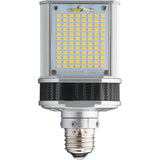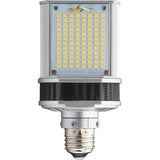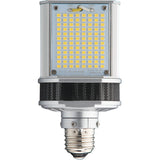How to Read Outdoor Fixture Light Distribution Classification Systems
Posted by Dave on for ProLampSales
Fixtures can be categorized by application, mounting, light source, construction and light distribution. In this post, the focus will be on light distribution.
For lighting specifiers and contractors, it's important, particularly for outdoor fixtures, to know the light distribution pattern and characteristics of the distribution. The shape (as well as brightness) of the area that is illuminated by the fixture will determine the effectiveness of the lighting for the intended purpose. It may also influence the number of fixtures and the spacing between the fixtures installed.
NEMA
There are two fixture light distribution classification systems. One has been developed by the National Electrical Manufacturers Association (NEMA). This system is used primarily for flood lighting and sports lighting fixtures. It describes the distribution of light within the beam produced by the fixture. There are seven beam types in the NEMA classification. Each beam type includes metrics for beam spread and light projection distance to define the distribution.
| Beam Type | Beam Spread | Beam Projection Distance |
| 1 | 10° to 18° | 240 ft. and greater |
| 2 | 18° to 29° | 200 to 240 ft. |
| 3 | 29° to 46° | 175 to 200 ft. |
| 4 | 46° to 70° | 145 to 175 ft. |
| 5 | 70° to 100° | 105 to 145 ft. |
| 6 | 100° to 130° | 80 to 105 ft. |
| 7 | 130° and up | under 80 ft. |
For an asymmetrical beam spread, beam types can be combined. For example, 120° horizontal x 90° vertical would be shown as NEMA 6 x 5.
Note: Some fixtures can be ordered in different NEMA distribution patterns to fit the requirements of the the project.
IESNA
A second light distribution classification system is published by the Illumination Engineering Society of North America (IESNA). This system describes the shape of the area that is illuminated by the fixture. This system is used primarily for area lighting and roadway lighting applications.
| Name | Description of Light Distribution |
| Type I | Narrow, symmetric illumination pattern |
| Type II | Slightly wider pattern thatn Type I |
| Type III | Wide illumination pattern |
| Type IV | Widest illumination pattern |
| Type V | Symmetrical circular illumination pattern |
| Type VS | Symmetrical nearly square illumination pattern |
The NEMA and IESNA classification designations, often provided in the product data sheets from many manufacturers, may give the designer enough information to determine whether or not the light fixture will meet the requirements of the intended application.
Photometric reports, also available from many manufacturers, give a more detailed description of the illumination including brightness levels within the light distribution pattern.
A related issue with outdoor fixtures is light cutoff which is discussed in another article.
- Posted in Fixtures
Featured Products (View All)
0 Comments




